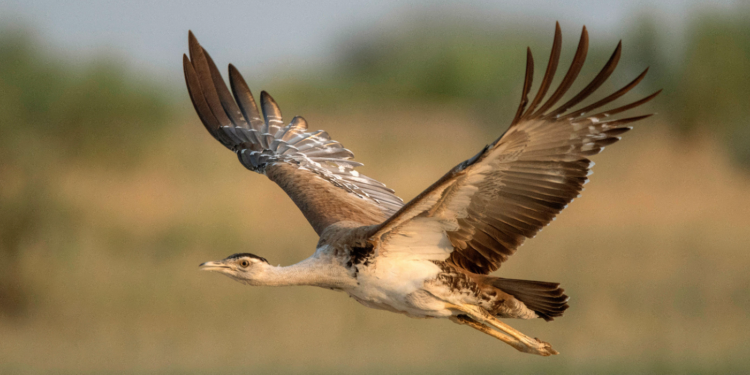There are growing fears that one of India’s iconic large birds, the great Indian bustard, is about to go extinct due to the growth of electric transmission lines in its home area of the Thar desert. Prioritising wind and solar power has led to a growth of transmission lines with the effect that the numbers of birds could have dropped to 150. This is just the latest evidence that industrialising large areas of wildlife habitat is causing worrying losses to the population of large raptors and birds, bats and whales. Last October, the Daily Sceptic reported that wind farms in Tasmania have reduced the population of the endangered local wedge-tailed eagle to around 1,000 individuals. Large numbers of whales have beached along the U.S. east coast in recent years as offshore wind farm industrialisation has disrupted the migration, mating and feeding habits of some of the most endangered whale species in the world.
In 2021, a paper produced by the Wildlife Institute of India warned that the great Indian bustard was at “imminent risk of extinction due to power line mortality”. Mortality was said to be “positively related” to the number of wires. Many other large birds were said to be at risk, and the researchers found that around 50 birds die annually per kilometre of power lines in the Thar desert due to collision and electrocution.
According to the Wildlife Institute of India, over 100,000 birds of diverse species are killed each year as a result of electrocution from transmission lines connecting wind and solar to the grid. In 2022, two Spanish ecologists confirmed that electrocution on power pylons was a major cause of bird mortality worldwide, including for some severely endangered species. They noted that power lines were “not bio-diversity-friendly”. Prerna Singh Bindra, a wildlife conservationist and former member of the National Board for Wildlife, comments:
In recent years, the death blow to the great Indian bustard has come from unexpected quarters – the expanse of wind farms and power transmission lines that criss-cross its last remaining habitats… The question that needs to be asked is, how green is renewable energy when it leads to the extinction of a critically endangered species?
Of course that last question is the one question that will not be asked. Indeed on past evidence it will be studiously avoided and helpful messengers in the mainstream media will be easily persuaded that deaths are due to other factors such as ‘climate change’. Bird and bat protection societies around the world are invariably in favour of green ‘sustainable’ wind and solar power, and they turn an almost blind eye to the mass slaughter by making mealy-mouthed safety suggestions. But of course the fact is that large raptors such as eagles and bustards rely on wind currents, as do gigantic wind turbines, and the two meet far too often. Worldwide, bustards are at particular risk from power cables due to the birds’ heavy weight, large wing span and limited manoeuvring ability.
The New York Times recently reported that electrocution isn’t the main thing killing birds along power lines. It was relaying the findings of a paper that said bullet fragments had been found in a number of dead birds lying under lines in four western states. Four hundred whales have been washed up on the eastern U.S. coastline since 2016, including nearly two dozen in the three months to February 2023.There is “no evidence” to support claims that industrial noise has impeded the whales ability to navigate and communicate, notes the New Scientist. The bulk of the strandings may have been caused by “changing ocean currents related to climate change”. Deafening rock-concert-grade sonar noise bouncing around hundreds of miles of ocean, constant pile-driving, massive ocean building works and heavy shipping movements have, of course, nothing to do with it – move along please, nothing to see here.
Nothing it seems must get in the way of the green industrial revolution. In California, the Democrat state Government recently relaxed controls on wildlife protections to allow permits to kill previously fully protected species for renewable energy and infrastructure projects. Nothing is sacred and protected from the slaughter – even America’s national bird, the bald eagle. A typical green reaction came from the Audubon California Policy Director Mark Lynas who said we need renewable energy resources, and he did not want to see the eagle deaths “being used to push against clean energy”.
In addition to the large bird kill, wind turbines are estimated to chomp millions of bats around the world every year. Any concern for the depredation of wildlife, whether on or offshore has tended to focus on these huge blots on the land- and seascapes. But according to the International Energy Authority, achieving Net Zero means building 80 million kilometres of new and refurbished power lines within 17 years, equivalent to wrapping the Earth 2,000 times with new electricity grid capacity. All these high voltage cables will be needed to benefit from the intermittent power produced by vast numbers of new wind turbines. To achieve Net Zero, the countryside will need to be blanketed with turbines and ubiquitous cables strung to bring the power to distant urban areas. Of course, as it becomes clearer by the day, Net Zero will not be achieved since the breezes and sunbeams are unreliable, so full stand-by gas turbines will have to be maintained.
It is possible that some other cheap and reliable back-up fuel will be discovered or invented in the next few years – and pigs might fly, although that would not be advisable across much of the future countryside.
Chris Morrison is the Daily Sceptic’s Environment Editor.











To join in with the discussion please make a donation to The Daily Sceptic.
Profanity and abuse will be removed and may lead to a permanent ban.
You can’t destroy enough beauty or kill enough animals to save the planet, Gaia is priceless.
Bird chopping turbines – 500 to 1500 dead large fowl every year, per chopper.
Solar panels and chopper cable connections to the grid – hundreds dead in every area of dense cabling and Indian Bustard is just the latest casualty.
Forests, farms, wildlife areas raped and destroyed to build these useless technologies.
All built with hydrocarbon based technologies and products.
Clean and green we are told…..yet I am immoral and fascist/phobic/anti-xxx for opposing such stupidity and destruction.
Isn’t physical collision on overhead cables the real problem with birds, not electrocution? Near where I live there’s a pylon on a 132 kV line which is quite popular with birds at certain times of day. Some like to perch on the top, presumably to keep an eye on things worth eating, and loads more like to perch on the neutral cable around sunset.
Some of the overhead ones on wooden poles have optical disks attached to make them more visible to birds as well. https://www.ukpowernetworks.co.uk/news/swans-and-geese-are-safer-thanks-to-power-company and many similar items.
And in any case, the problem is NOT exclusive to renewables either.
If only we had a National or even International charity to protect the birds and other species or even a world famous elderly ‘natural world mouthpiece’ to speak up about this situation.
Attenborough would fit the bill but he is already batting for the other team.
I recently “challenged” an RSPB activist on one of their stalls about their support for the bird-slaughtering windmills.
Her response: “We are consulted during the planning stage.”
I presume they estimate how many birds are likely to be slaughtered and then give the Eco Nutters their approval!
Well done with your ‘challenge’ and as you found they are not concerned about this matter even though the charity was formed to er protect birds!
Ah, the “consultation.”
And after the “consultation” we will do whatever we originally intended anyway.
Always.
The Red Kite and raptors in general who have low productive rates are being lost to wind turbines and in Germany in particular there is a problem because they have the most turbines (about 40,000). Hawks are always looking down for prey and they do not see the blades coming. The idealistic environmentalist who always hark after some utopian pristine environment that they imagine must have existed before humans conveniently ignore damage caused by their chosen planet saving technologies. Net Zero is the agenda that trumps all other considerations.
I ofcourse meant reproductive rates
Keep going with Inconvenient Truths about the wildlife and environmental destruction being carried out in the name of “green.”
There is nothing environmentally friendly about the Net Zero Lunacy.
It’s almost like Nikola Tesla’s idea of wireless electricity was superior. Failing that, the power lines can simply be buried underground.
“Estimates suggest that between 10,000 and 100,000 birds are killed by turbine blade strikes annually in the UK.
That’s a lot, but it’s worth noting that approximately 55 million birds are killed in the UK each year by domestic cats. Nevertheless, research suggests there may be ways to make wind turbines safer for wildlife. For example, a small-scale study in Norway found that painting one of the wind turbines blades black, reduced bird deaths by 70 per cent.”
https://www.sciencefocus.com/science/how-many-birds-are-killed-by-wind-turbines-in-the-uk/
I remember one US study saying that since birds are flung a couple of hundred metres away after being struck by turbine blades, the companies restricted their surveys to only 50 metres around the base of the turbines, and announced there were no bird fatalities.